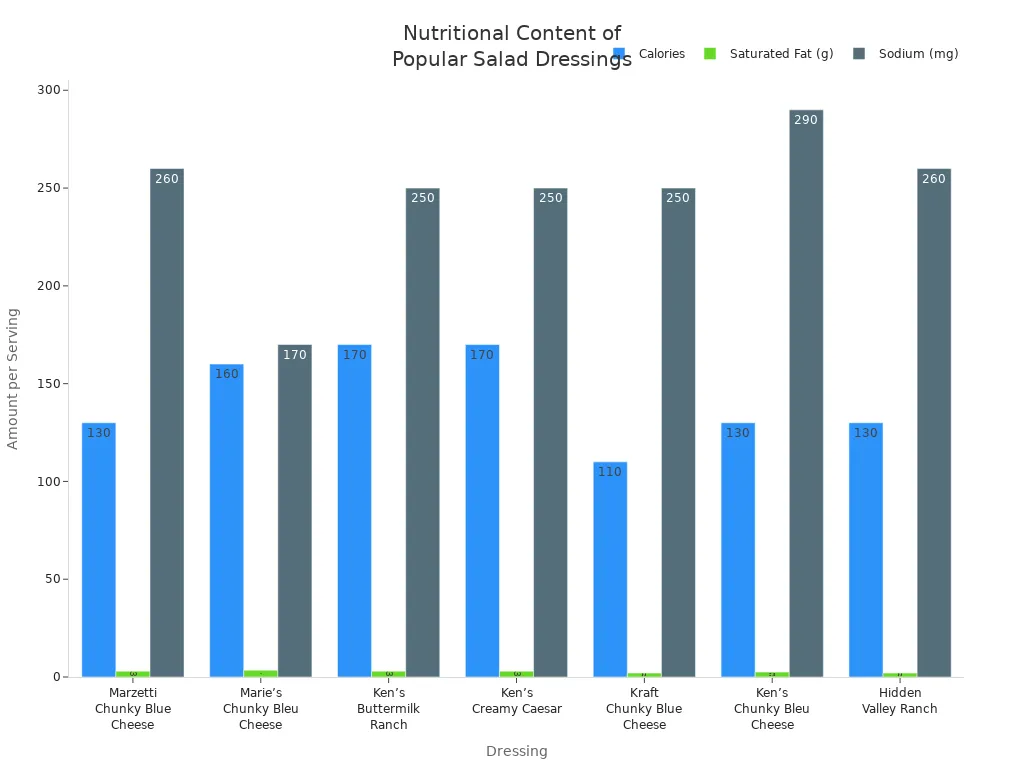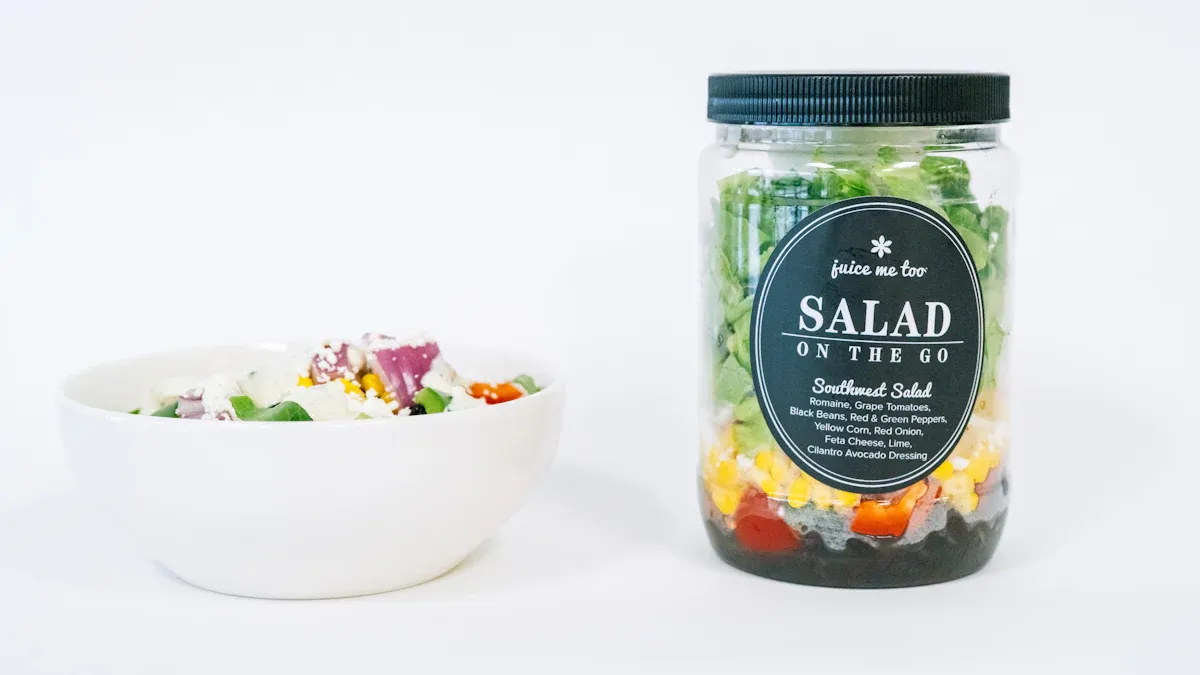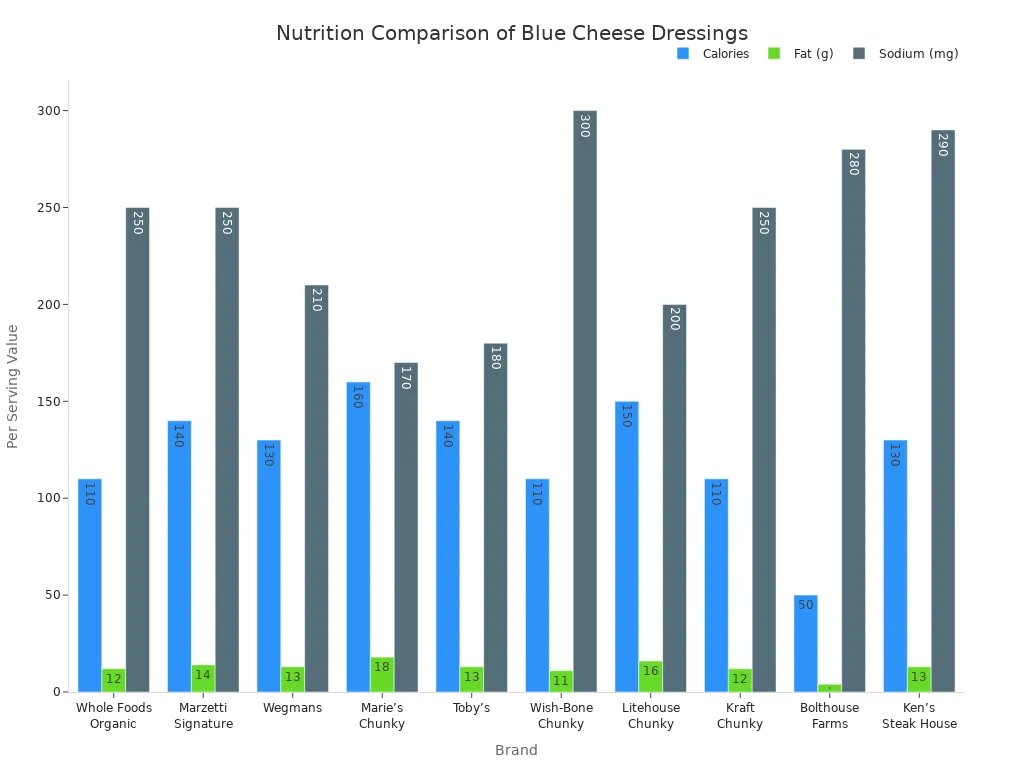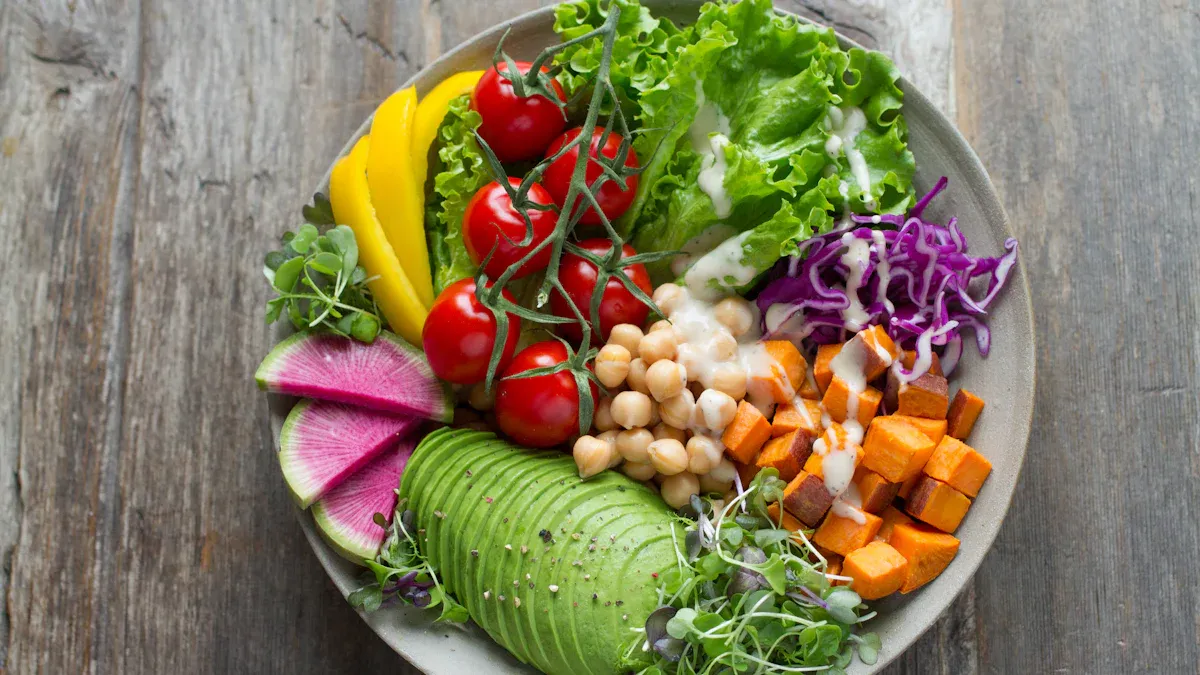- All
- Product Name
- Product Keyword
- Product Model
- Product Summary
- Product Description
- Multi Field Search
Views: 479 Author: Site Editor Publish Time: 2025-03-26 Origin: Site







Blue cheese dressing is considered the unhealthiest salad dressing. It contains a high amount of saturated fat, calories, and sodium, making it a poor choice for those who prioritize their health. The table below outlines the nutrition facts for some popular brands:
| Dressing | Calories | Saturated Fat | Sodium |
|---|---|---|---|
| Marzetti Chunky Blue Cheese | 130 | 3 g | 260 mg |
| Marie’s Chunky Bleu Cheese | 160 | 3.5 g | 170 mg |
| Ken’s Buttermilk Ranch | 170 | 3 g | 250 mg |
| Ken’s Creamy Caesar | 170 | 3 g | 250 mg |
| Kraft Chunky Blue Cheese | 110 | 2 g | 250 mg |
| Ken’s Chunky Bleu Cheese | 130 | 2.5 g | 290 mg |
| Hidden Valley Ranch | 130 | 2 g | 260 mg |

Many people in the Midwest enjoy blue cheese dressing, and it is quite popular in certain states. However, its nutrition facts clearly indicate that it is not as healthy as other dressings.
Blue cheese dressing has a lot of saturated fat. It also has many calories and a lot of sodium. This makes it a bad choice for salads. - Many brands put in extra sugars and preservatives. These things add more calories and make the dressing less healthy. - Picking better dressings, like olive oil and vinegar, is smart. Greek yogurt is also a good choice. These can help you eat less fat and fewer calories. - Always look at nutrition labels before you buy salad dressings. Check for extra sugars and bad ingredients. - Making your own dressings at home is a good idea. You can pick what goes in them. This helps you make better choices for your salads.

Image Source: unsplash
Blue cheese dressing is the least healthy salad dressing. This is because of what goes into it. Most brands mix oils, dairy, and flavor boosters. The main things in blue cheese dressing are soybean oil, buttermilk, blue cheese, water, distilled vinegar, egg yolk, sugar, salt, and spices. These make the dressing high in fat and packed with sugar. The list also has things like xanthan gum to make it thick and yeast extract and mustard seed for more taste.
| Ingredient | Nutritional Contribution |
|---|---|
| Soybean Oil | Gives fats |
| Buttermilk | Has protein and calcium |
| Blue Cheese | Adds taste, protein, and calcium |
| Water | Hydrates |
| Distilled Vinegar | Makes it sour and tasty |
| Egg Yolk | Has fats and proteins |
| Sugar | Makes it sweet |
| Salt | Makes it taste better |
| Dried Garlic | Adds taste and may help health |
| Xanthan Gum | Makes it thick |
| Natural Flavor | Makes it taste better |
| Mustard Seed | Adds taste and may help health |
| Yeast Extract | Adds umami taste |
Some brands add sour cream or nonfat buttermilk for more creaminess. The ingredient list sometimes hides extra sugars. These sugars make the dressing have more calories. Many brands use fake ingredients to keep the dressing fresh and thick.
The nutrition facts show why blue cheese dressing is not healthy. One serving can have up to 18 grams of fat. A lot of this fat is saturated fat. Each serving has between 110 and 160 calories. It is easy to eat a lot without knowing it. The sodium is also high. Some brands have up to 300 milligrams in one serving. These facts show blue cheese dressing is high in fat and sugar.
| Brand | Calories | Fat (g) | Sodium (mg) |
|---|---|---|---|
| Whole Foods Organic Blue Cheese Dressing | 110 | 12 | 250 |
| Marzetti Signature Blue Cheese Dressing | 140 | 14 | 250 |
| Wegmans Blue Cheese Dressing | 130 | 13 | 210 |
| Marie’s Chunky Blue Cheese Dressing | 160 | 18 | 170 |
| Toby’s Blue Cheese Dressing & Dip | 140 | 13 | 180 |
| Wish-Bone Chunky Blue Cheese Dressing | 110 | 11 | 300 |
| Litehouse Chunky Blue Cheese Dressing | 150 | 16 | 200 |
| Kraft Chunky Blue Cheese | 110 | 12 | 250 |
| Bolthouse Farms Chunky Blue Cheese Yogurt | 50 | 4 | 280 |
| Ken’s Steak House Chunky Blue Cheese | 130 | 13 | 290 |

These numbers show blue cheese dressing has lots of sodium and fat. Some dressings, like Bolthouse Farms, use yogurt to lower the fat. Most regular blue cheese dressings still have lots of calories. Extra sugars in the ingredients also add to the calories. People who eat blue cheese dressing often get more calories and sodium than they think.
Most blue cheese dressings from stores have additives and preservatives. These help the dressing last longer and stay thick. Xanthan gum makes it thicker. Natural flavors and yeast extract make it taste better. Many brands use fake ingredients to keep the dressing looking and tasting good. The ingredient list may also have extra sugars. These make it sweeter and hide the strong taste of blue cheese.
Some dressings have trans fats, which are bad for health. Added sugar and extra sugars make blue cheese dressing even less healthy. These additives and high sodium make blue cheese dressing the least healthy choice.
Note: Always look at the ingredient list and nutrition facts before picking a salad dressing. Many dressings hide extra sugars and fake ingredients that can hurt your health.
Blue cheese and ranch are both known as unhealthy dressings. They both have a lot of fat and calories. Ranch usually has a little less fat than blue cheese. But the difference is not very big. The table below shows how they compare:
| Dressing | Calories per 2 tbsp | Fat (g) | Protein (g) | Carbohydrates (g) |
|---|---|---|---|---|
| Ranch | 140 | 14 | <1 | 2 |
| Blue Cheese | 160 | 18 | N/A | N/A |
Ranch has a bit fewer calories and fat. But both can add up fast if you use more than one serving. People should watch how much they use.
Caesar dressing is also a popular salad topping. It is a lot like blue cheese dressing. Both have about the same calories in each serving. The table below shows their calories:
| Dressing Type | Calories per 2 tablespoons |
|---|---|
| Blue Cheese Dressing | 70 |
| Caesar Dressing | 70 |
Most Caesar dressings from stores have lots of fat and sodium. Blue cheese dressing is also high in fat. Most of its calories come from fat. Eating these dressings often can cause health problems.
Blue cheese dressing has lots of fat and sodium.
Caesar dressing also has a lot of fat and sodium.
Most calories in blue cheese dressing are from fat.
Catalina and vinaigrette dressings might look healthier. But many have a lot of sugar. Some brands add sugar with names like high-fructose corn syrup or maltose. Fruity vinaigrettes, honey mustard, and French dressings also have lots of sugar. The table below shows sodium and sugar in these dressings:
| Dressing Type | Sodium (mg) | Sugar (g) |
|---|---|---|
| Marie’s Lite Chunky Blue Cheese | 300 | 1 |
| Kraft’s Zesty Catalina Dressing | 350 | 8 |
| Kraft Classic Catalina Dressing | 320 | 8 |
Many dressings from stores have extra sugars, fillers, and fake ingredients. About 73% of salad dressings have added sugars. These sugars give calories but no nutrients. They can cause health problems like obesity and heart disease.
Tip: People should read labels for added sugars and fake ingredients. Dressings with lots of sugar may not be as healthy as they look.
The unhealthiest dressings have lots of fat, sodium, and sugar. Blue cheese dressing is known for its fat and sodium. Catalina and vinaigrette dressings can be bad because of their sugar.
Blue cheese dressing has a lot of saturated fat and sodium. These can make cholesterol and blood pressure go up. Doctors say eating too much saturated fat is bad for your heart. Too much sodium can make your body hold water and stress your heart. The table below lists some health risks from these ingredients:
| Health Risk | Description |
|---|---|
| Saturated Fats | Eating too much can raise cholesterol and hurt your heart. |
| Sodium | Too much sodium can cause your body to hold water, hurt your kidneys, raise blood pressure, and cause stroke. |
Some research says blue cheese has spermidine and bioactive peptides. These might help your heart and lower swelling. But most blue cheese dressings have so much fat and sodium that these good things do not help much. People with heart problems should not eat a lot of blue cheese dressing.
Many people use more than one serving of blue cheese dressing. Each serving gives extra calories and fat. Dressings with lots of calories, like blue cheese, can make you gain weight if you eat them a lot. The kind and amount of dressing you use matters. Regular dressings help your body use nutrients, but fat-free ones may have extra sugar that makes you want to eat more. Other toppings, like croutons and cheese, also add calories. If you want to keep your weight healthy, watch how much dressing you use.
Dressings with lots of calories can make you gain weight.
Fat-free dressings sometimes have extra sugar.
More toppings mean more calories.
Eating dressings with lots of saturated fat and sodium for a long time can cause big health problems. A diet with too much of these can make heart disease more likely. High sodium can make blood pressure go up and hurt your blood vessels. Over time, this can change how your blood vessels work and cause more heart issues. People who eat these dressings a lot may also get kidney disease or have a stroke.
| Nutrient | Recommendation |
|---|---|
| Saturated Fat | Less than 6% of all your calories |
| Sodium | Less than 5 grams each day |
Note: Health experts say to check nutrition labels and pick dressings with less saturated fat and sodium to stay healthier.

Image Source: unsplash
Olive oil and vinegar dressings are a healthy choice. Olive oil has good fats that help your heart. Balsamic vinegar gives flavor but almost no fat. These dressings have fewer bad ingredients than blue cheese dressing. The table below shows how they are different:
| Dressing Type | Calories per Tablespoon | Fat Content (grams) |
|---|---|---|
| Olive Oil | 120 | 14 |
| Balsamic Vinegar | 15 | 0 |
| Blue Cheese Dressing | Higher than 120 | Higher than 14 |
People can make olive oil and vinegar dressings at home. This way, they can pick how much salt and sugar to use. Many store vinaigrettes use simple things like extra virgin olive oil, balsamic vinegar, honey, and spices. Picking vinaigrettes instead of creamy dressings helps lower fat and sodium.
Tip: Always look at serving sizes. Using two tablespoons or less keeps calories and fat lower.
Greek yogurt dressings are a lighter option. They have less fat and fewer calories than blue cheese dressings. Greek yogurt gives protein and makes the dressing creamy. The table below compares a Greek yogurt dressing to a classic ranch:
| Dressing Type | Calories (per 2 tbsp) | Fat (g) | Saturated Fat (g) | Sugars (g) |
|---|---|---|---|---|
| Bolthouse Farms Yogurt | 45 | 3 | 1 | 1-6 |
| Hidden Valley Classic Ranch | 145 | 14 | N/A | N/A |
Greek yogurt dressings feel light and fluffy.
They have more protein than mayo-based dressings.
Homemade dressings let people pick every ingredient. Easy recipes use Greek yogurt, light mayonnaise, lemon juice, and spices. These dressings have less fat, sodium, and sugar than store-bought blue cheese dressing. Here is a sample recipe:
| Ingredient | Amount |
|---|---|
| Nonfat plain Greek yogurt | 3/4 cup |
| Reduced fat crumbled blue cheese | 1/2 cup |
| Light mayonnaise | 1 Tbsp |
| Fresh lemon juice | 1 Tbsp |
| White wine vinegar | 1 Tbsp |
| Garlic powder | 1/4 tsp |
| Black pepper | 1/4 tsp |
Calories: 40
Fat: 2g
Sodium: 120mg
Carbohydrates: 2g
Homemade dressings can be gluten-free and good for people with diabetes. Making dressings at home helps you skip hidden sugars and bad additives. People can also use feta cheese for less calories and sodium.
Note: Reading labels and making your own dressings are smart ways to eat healthier salads.
Blue cheese is known as the least healthy salad dressing. Experts say there are a few main reasons for this. First, blue cheese dressing has a lot of saturated fat. Second, it has a lot of sodium. Both of these can make cholesterol go up and hurt your heart.
People can look at nutrition labels to make better choices:
| Key Point | Explanation |
|---|---|
| Check Nutrition Facts and Ingredients | The label and ingredient list show hidden things and tricks from ads. |
| Know Serving Sizes | Serving sizes change the numbers; small sizes can make food look healthier. |
| Look at Calorie Sources | Not all calories are the same; calories from whole foods are better than from processed foods. |
| Watch for Added Sugars | If sugar is one of the first three ingredients, be careful; watch out for all types of added sugars. |
Picking healthier dressings helps people stay away from the problems that come with the least healthy salad dressing. Even small changes can help you eat better and feel healthier.
Blue cheese dressing has a lot of saturated fat, calories, and sodium. These can make cholesterol and blood pressure go up. Many brands add sugar and preservatives. This makes the dressing have more calories. It also makes salads less healthy.
People can eat blue cheese dressing if they use a small amount. Using it only sometimes helps lower health risks. Picking lighter or homemade kinds with less fat and sodium is better for health.
Not every creamy dressing is just as unhealthy. Some, like Greek yogurt dressings, have less fat and more protein. Reading the nutrition label helps people pick dressings with fewer calories, less fat, and less sodium.
People can use olive oil, vinegar, lemon juice, and herbs to make dressings. Greek yogurt makes dressings creamy without much fat. Making dressing at home lets people control salt, sugar, and fat.
Blue cheese gives calcium and protein. Some studies say blue cheese has things that may help the heart. But most blue cheese dressings have so much fat and sodium that these good things do not help much if you eat them often.